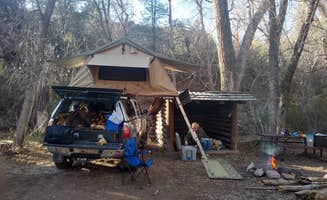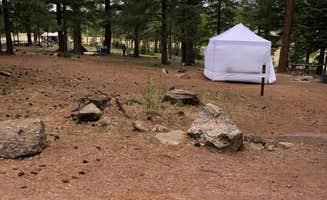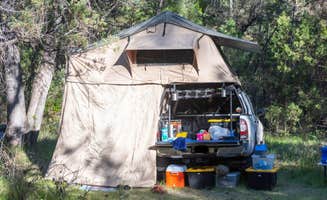Tent camping options near Blue, Arizona cluster around rugged wilderness terrain in the Apache-Sitgreaves National Forest. The area sits at elevations between 5,000 and 9,000 feet, creating distinct seasonal conditions with summer highs rarely exceeding 85°F. Most campsites require navigating unpaved forest roads, with accessibility varying significantly during spring snowmelt and summer monsoon periods.
What to do
Hiking at Cutthroat Campground: Access trails with lake views and moderate terrain suitable for day hikes. "Sites are more private that brookchar (next site over) but only have vaulted toilets, no running water in bathrooms," notes Candy P., who recommends planning accordingly for water needs.
Fishing at Reservation Lake: The lake provides trout fishing opportunities during summer months. Ryan V. reports, "Lake has some great fishing and excellent scenery," though catches tend to be more frequent in early morning or evening hours when temperatures are cooler.
Stream exploration: Small children can wade safely at some Blue River access points during low water periods. According to Daren W. at Upper Blue Campground, there's a "Minute walk to blue river. Lots of fun to play and climb/hike" with shallow areas appropriate for supervised water play.
Wildlife observation: Dawn and dusk provide prime viewing hours for deer, elk and birds. Bring binoculars and maintain proper food storage protocols in all camping areas to avoid attracting wildlife to your site.
What campers like
Solitude and space: The low density of campsites creates privacy uncommon in more developed areas. Jon U. at Upper Blue Campground notes, "I camped here on the 4th of July. Although I planned to go somewhere higher, I couldn't pass on this site when I saw it."
Natural camping surfaces: Most sites feature minimal development, allowing for camping on natural terrain. "Not all spots are level, but the views are great!" explains Candy P. about Cutthroat, highlighting the trade-off many campers appreciate between convenience and natural setting.
Weather refuge: Summer temperatures typically run 15-20 degrees cooler than Phoenix or Tucson. Ryan V. describes Reservation Lake as an "Awesome summer retreat for cooler weather," making it a popular destination during hotter months.
Natural resources: Fallen timber provides campfire materials where permitted. Daren W. mentions that Blue Crossing Campground has "Plenty of downed trees for firewood" which reduces the need to bring firewood from outside areas.
What you should know
Water availability: No reliable potable water exists at most primitive sites. Bring 1 gallon per person per day minimum, with additional for cooking and cleaning needs.
Road conditions: Forest roads deteriorate significantly during wet weather. Jon U. warns about Upper Blue Campground: "4x4 is probably required," indicating the rough access even during dry conditions.
Limited services: No cell service exists in most camping areas. The nearest reliable supplies are in Alpine, approximately 25 miles from most campsites.
Lake access considerations: Some lake sites require short hikes from parking areas. Dave R. explains about Cutthroat Campground: "You have to hike your stuff up a small hill from the car. Views are spectacular and great shade. All of the lower spots 3-8 good lake access."
Tips for camping with families
Site selection strategy: Choose sites with natural features that create boundaries for smaller children. At Cutthroat Campground, "Spot 19 is really the best. Great views, shade, close to bathroom (pit toilets) and car accessible," recommends Dave R., highlighting a family-friendly option.
Cultural connections: Introduce children to local history through accessible archaeological sites. Daren W. mentions Blue Crossing Campground offers "Hiking trails and petroglyphs," providing educational opportunities within walking distance.
Weather preparation: Pack for significant temperature variations, particularly in spring and fall. Daytime temperatures can reach 80°F while nighttime drops below 40°F, requiring layered clothing systems for comfort.
Shelter options: Consider lean-to structures for additional weather protection with children. "Only 3 sites, two with lean to's," reports Daren W. about Blue Crossing Campground, which can provide additional shelter during unexpected weather.
Tips from RVers
Size limitations: Most tent camping areas near Blue cannot accommodate vehicles longer than 20 feet. Narrow forest roads with tight turns prevent larger RV access to primitive sites.
Alternative base camps: Consider established campgrounds in Alpine for larger vehicles, making day trips to Blue area attractions. Shane W. suggests Pratt Lake Dispersed as an option with less challenging access: "Road is a little rough going in, in places," but notes it remains accessible for appropriate vehicles.
Seasonal access windows: Plan RV visits during drier periods between monsoon seasons. Shane W. notes at Hulsey Lake Fishing Site that there is "plenty of dispersed to be found up the road further all the way to Terry Flat," but cautions to be respectful when driving near residential areas.
Supply planning: No hookups or dump stations exist in immediate Blue vicinity. The closest RV services are in Alpine or Springerville, requiring comprehensive self-sufficiency for stays.





